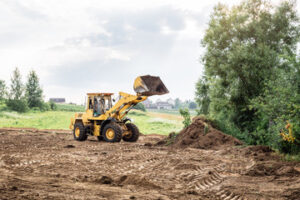A quality excavation contractor does more than just move dirt. Their work sets the stage for a construction project’s success, ensuring the foundation upon which structures are built is stable and secure.

They also integrate vital infrastructure such as sewage, electricity, water and gas systems into the site, digging narrow trenches and laying them out accurately. Visit bartexcavationllc.com to learn more.
Excavation contractors play a crucial role in construction projects, from transforming landscapes into bustling building sites to providing the very foundations upon which buildings and structures will be built. These professionals use specialized knowledge, sophisticated equipment, and meticulous work to assess the land, clear debris, dig holes for foundations, install utilities, and facilitate site development for various commercial and residential construction projects. In doing so, they set the stage for the rest of a project’s duration, directly influencing its stability and success.
One of the first tasks that excavation contractors perform is assessing and clearing the area where a project will take place. This involves identifying existing dangers or – in the case of historical artefacts – making sure that they are protected and preserved for future generations to enjoy. In addition, this phase of a job can involve digging trenches that are necessary for installing underground utilities.
Once the work site has been cleared and prepared, excavation contractors can begin their digs. They will usually start by digging the foundations of a new building, which may involve excavating up to 24 inches deep. They will also need to ensure that the foundation is sloped away from the structure to prevent problems with drainage later on.
Following the foundation dig, excavating contractors will then grade the site by adjusting the ground’s elevations as outlined in the construction plans. This ensures proper drainage and prevents the foundation from collapsing due to excess water or improper grading.
In some cases, a construction site may need to be regraded for other purposes. For example, a highway project might require the creation of a median, which requires the excavation and placement of materials. Excavation contractors can also provide services that are more focused on landscaping, such as preparing areas for landscaping, creating parking lots, and providing roadways.
When excavation takes place in an urban environment, these professionals must exercise extra vigilance to make sure that nearby homes do not experience damage. This may involve employing spotters and posting signs, as well as using physical barriers to limit access to the excavation area. Automobile exposures are also a concern, given that the excavation process may necessitate the transport of oversize machinery and vehicles on local roads. These contractors will typically obtain the appropriate permits to ensure that they are compliant with all regulations.
Integrating Vital Infrastructure
When it comes to laying the foundation for new construction, excavation contractors do far more than simply move dirt. They also manage vital infrastructure systems like sewage, electrical, water, and gas lines as well as telecommunications and ensure that these are adequately incorporated into the site development process. This not only allows for proper operation of the final structure, but it prevents unforeseen problems that may derail construction later on in the project.
One of the biggest challenges that can be encountered during the excavation process is running into buried utility lines, which can cause significant disruptions and add additional costs to projects. To minimize these risks, excavating professionals utilize techniques such as white-lining, which involves highlighting the dig area with paint or stakes to make it easier for locators to locate and mark utility lines.
Another challenge that excavation contractors are often tasked with is overcoming unstable soil conditions. In such cases, they may use soil stabilization techniques like soil nailing or micropiling to strengthen the ground and provide a firm foundation for construction projects. These services are especially crucial for projects in areas with soft, sandy, or waterlogged soils.
Lastly, excavation contractors are responsible for removing any hazardous materials or contaminants from a construction site. This may include underground storage tanks, asbestos-containing materials, or contaminated soil. These materials must be carefully removed and disposed of in accordance with strict safety protocols.
In addition to handling the initial site preparation, excavating contractors are also responsible for preparing roads. This involves excavating trenches for the road, installing utilities, and managing drainage-a key factor in the longevity of any road surface. In some cases, they also coordinate with paving teams to lay the actual pavement.
Site Development
In addition to preparing the ground for the construction of building foundations, utilities, and infrastructure, excavation contractors handle site development services for projects of all sizes. They are often one of the first teams to arrive at a job site, and their work sets the stage for the rest of a construction project, influencing its speed and effectiveness.
Site development services for a construction project include soil excavation, utility trenching, grading, erosion control, and demolition. Excavating contractors use heavy machinery such as excavators, backhoes, and bulldozers to complete these tasks. They ensure that they are following safety regulations and working with appropriate equipment to ensure a safe work environment. They are also skilled at navigating complex issues such as site access, avoiding underground utilities, and addressing unanticipated ground conditions.
Excavation contractors also dig holes or trenches for utilities such as water, sewer, electrical, and communication lines. These utilities are then backfilled and connected to the building’s foundation. This work is crucial for ensuring the stability of a building or other structure and preventing the need for future maintenance.
Depending on the specific construction goals of the project, excavating contractors may install specialty soils to improve the load-bearing capacity or drainage of the ground. They can also stabilize the soil through soil compaction or the addition of stabilizing materials. Erosion control is another critical service provided by excavating contractors, who use techniques like sediment basins and silt fences to prevent contaminated soil from entering nearby waterways and polluting local ecosystems.
Before construction begins, demolition services are provided by excavation contractors to remove any existing structures or debris from the construction site. This process can be complicated, and skilled excavation contractors understand how to remove and dispose of old or damaged materials quickly and efficiently. They also manage the grading process, shaping the land so that rainwater drains away from the construction area instead of pooling or flooding the construction site.
In some cases, contaminated soil must be removed and replaced before construction can begin. Excavation contractors are experienced in handling soil remediation for various types of contamination, including asbestos, lead, and septic system pollution. They can then replace the contaminated soil with clean material, ensuring that the construction will be safe and effective.
Remediation
As the first step in a construction project, excavation is crucial for shaping the site and ensuring that future building activities will be successful. For this reason, it is imperative that the professional excavating contractor you hire has experience and is capable of addressing all the potential problems that may arise. Some of the most important services offered by an excavation specialist include contaminated soil remediation, drainage management, and road construction.
Contaminated soil remediation involves identifying and managing harmful substances in the ground to protect workers, the environment, and the public from health risks. This is an extremely common issue in urban and industrial areas, where previous activities may have left dangerous materials in the soil. Professional excavation contractors understand the proper methods to safely remove and dispose of contaminated soil, as well as how to restore the land to its natural condition.
When it comes to construction of roads, excavation is vital for creating a stable base and installing necessary utilities. This includes laying water, sewer, and electrical lines, as well as managing drainage to minimize erosion and ensure the longevity of the road surface. Excavating contractors also coordinate with paving teams to ensure that roads are constructed correctly and efficiently.
While property exposures at an excavation company’s headquarters are limited, their job sites often present many hazards. For example, vehicles and equipment must be transported on roads that may be narrow or uneven in rural areas. This can increase the risk of collision, especially when oversized equipment is involved. Furthermore, the equipment may be exposed to damage from rocks, land or mud slides, sinkholes, floods, and vandalism.
As a general rule, contractors should notify local utility providers before beginning any significant digging work. These professionals can then come to the site and mark their respective lines, preventing excavation crews from accidentally hitting them and causing costly disruptions to a construction project. In addition to avoiding the dangers of hitting underground pipes and cables, professional excavation contractors can help prevent delays and extra costs by keeping the construction schedule on track.
